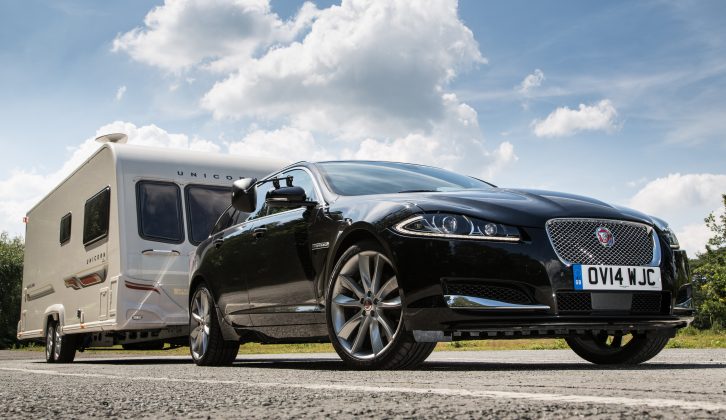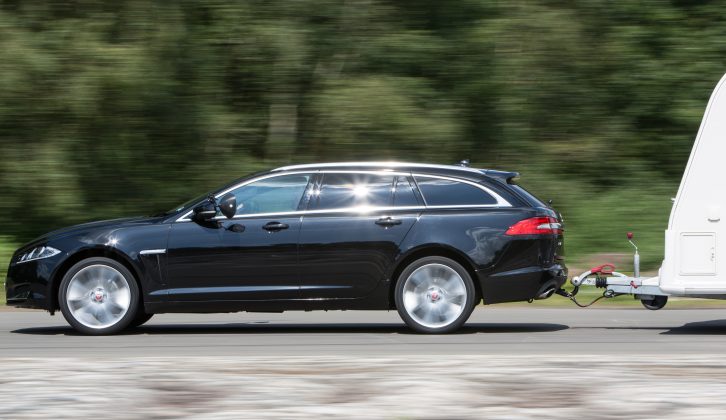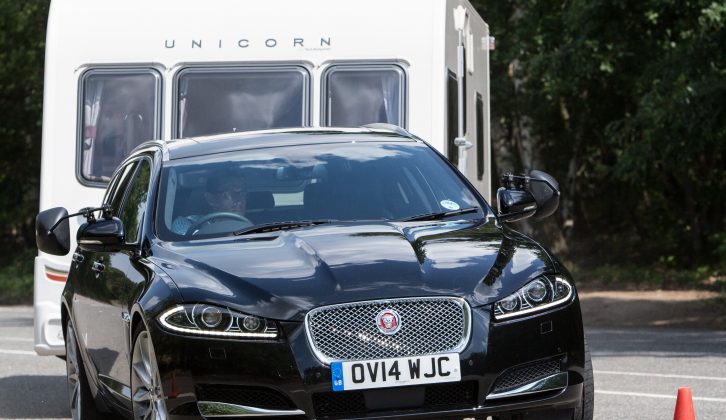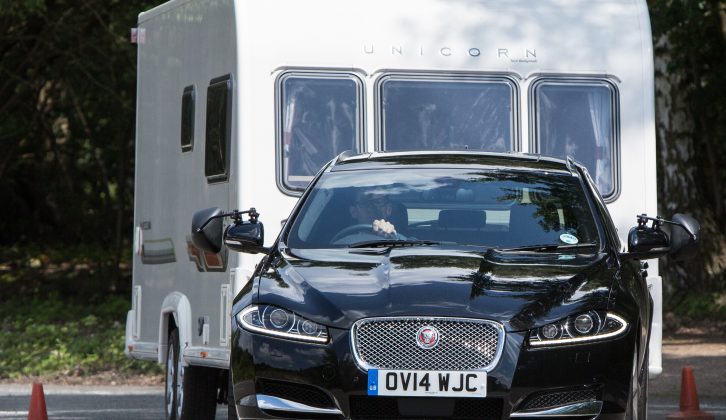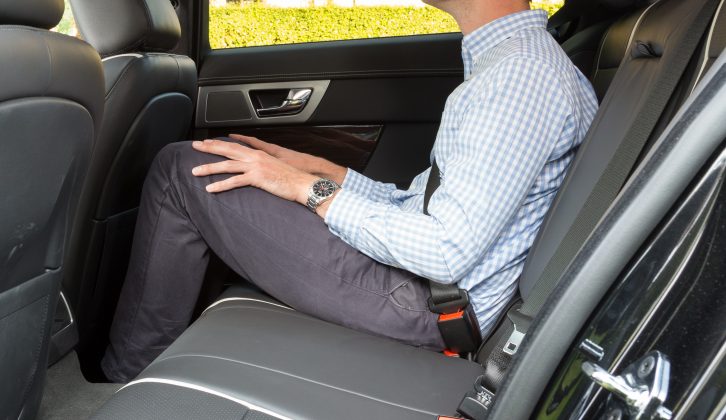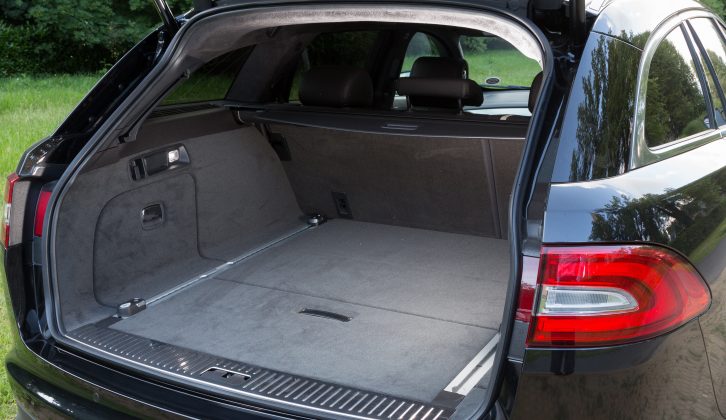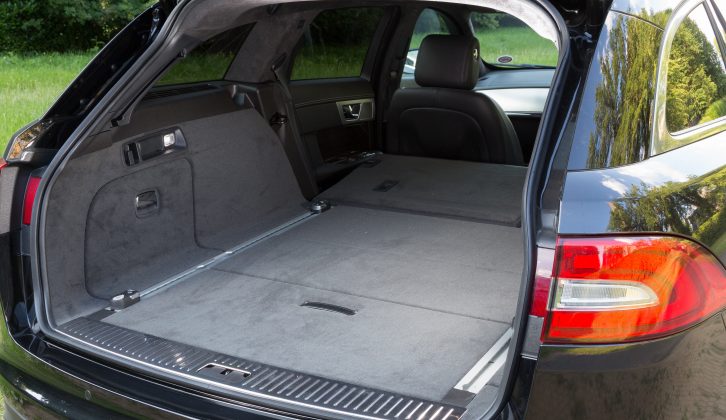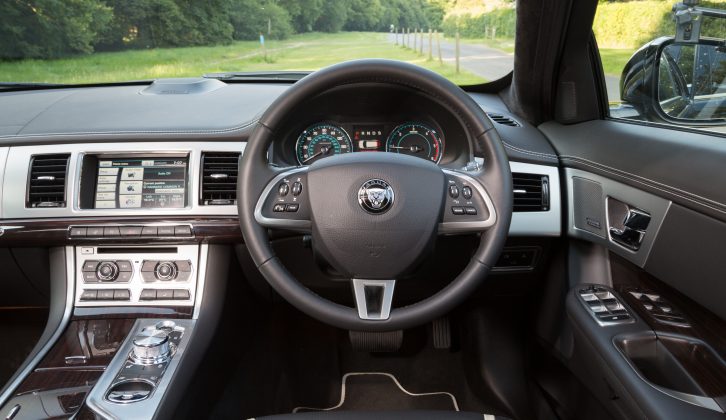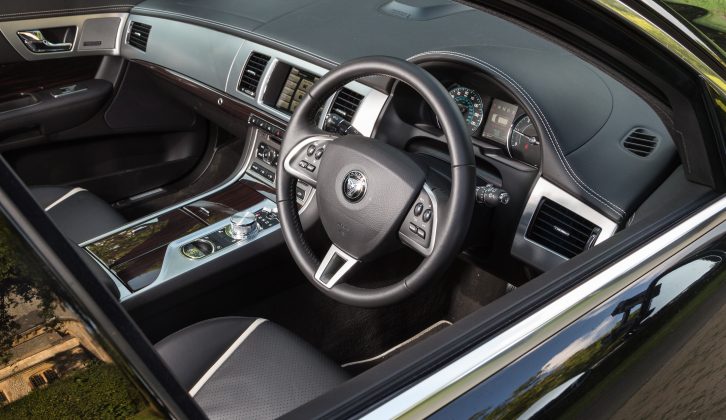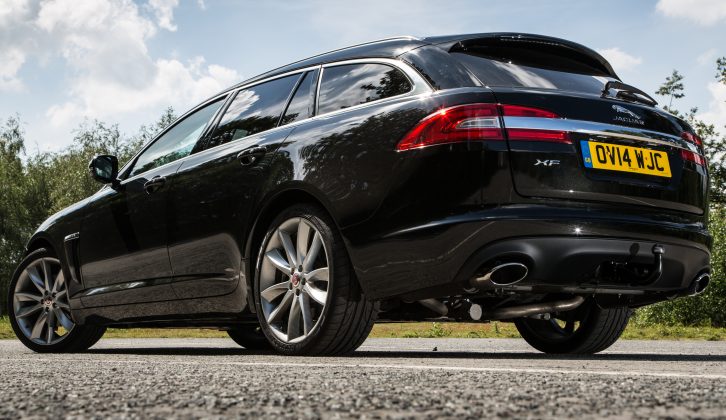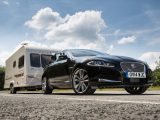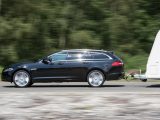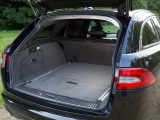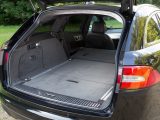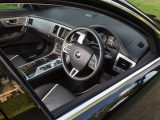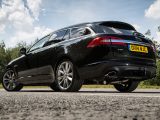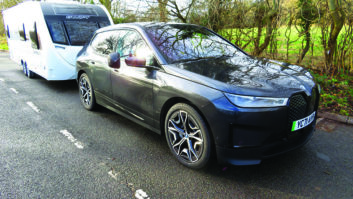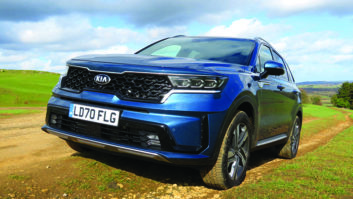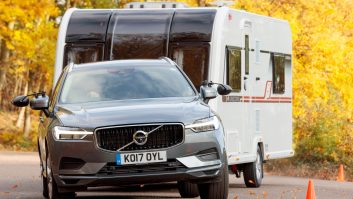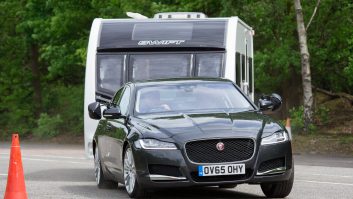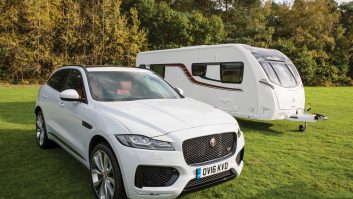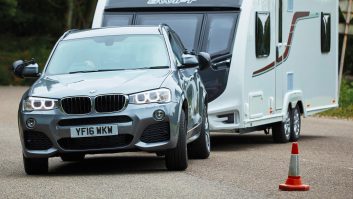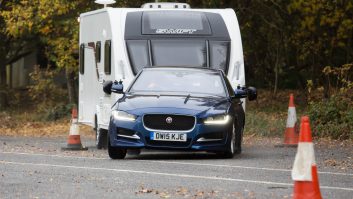Verdict
Spending a full week with the Jaguar makes us want one all the more. It really is a great car to drive, with or without a caravan behind it.
Throughout the Practical Caravan Jaguar XF Sportbrake review, the wagon revealed that as a tow car, its outstanding feature is stability. Whether driving on the motorway or swerving to avoid an accident, the XF is resolute, predictable and firmly in control of the caravan.
The Jag’s stability is matched by serious performance. We wondered whether the less powerful version of the XF’s 3.0-litre diesel would be underwhelming, particularly after we had made the S version a class winner at the Tow Car Awards. However, with its 368lb ft of torque, this version certainly doesn’t hang around.
Strong brakes stop the Sportbrake as well as the engine makes it go, with a very short stopping distance from 30mph.
In day-to-day driving, the XF is outstanding. Few cars so deftly combine a comfortable ride with nimble handling. Whatever the journey, the Jaguar is well suited to it; it is as much at home on the motorway as it is taking the long way on a favourite B-road.
As an estate car, the XF Sportbrake makes the grade, but only just. There is no escaping the fact that there are plenty of rival estates on the market that offer more room for bags and extra space for rear-seat passengers. Judged purely on load-carrying ability, the Mercedes-Benz E-Class Estate is a better choice.
However, with a capacity of 550 litres, the Sportbrake’s boot is hardly small. Besides, we’d happily pack carefully if it meant we could tow with the XF – what a tow car!
Pros
Superb performance and stability with or without a caravan in tow
A comfortable ride and nimble handling
Excellent finish in the cabin
It holds on to 45% of its value after three years or 36,000 miles
Cons
The Jag falls short of prestige rivals’ boot space, fuel economy and safety ratings
Rear visibility could be better, the parking sensors notwithstanding
Intrusive transmission tunnel makes rear seat better for two than for three
Practical Caravan’s tow car experts have driven the Jaguar XF Sportbrake before — it has twice won its weight class in the Tow Car Awards — but this was their first chance to give Jag’s stylish estate the full tow-test treatment.
The 3.0-litre S with 271bhp was named the Tow Car Awards 2014 1700-1899kg champion. Here we reviewed the less-powerful 3.0-litre, which still has 237bhp. A little less muscle under the bonnet means more money in your bank account — £4380, compared with the S in the same Portfolio specification. Which is the better buy? If you’re considering what tow car to buy next, should you save the extra pennies and get the S or not?
The reviewers were expecting a brilliant, super-stable tow car with precise handling. Does the less-powerful model have enough poke to cope with a heavy tourer?
The Jaguar gripped strongly however violent the change of direction, and bullied the caravan into following at speeds that would have been impossible for many cars
Towing
It’s a shame there’s no four-wheel-drive version of the Jaguar XF Sportbrake, and the 75kg towball limit is on the low side. However, otherwise, the Practical Caravan tow car review team found the estate to be an absolute pleasure to tow with.
It is brilliantly stable. We hitched it to a twin-axle 2011 Bailey Unicorn Barcelona with a mass in running order (MiRO) of 1593kg. Since the Jaguar’s kerbweight is 1880kg, the Bailey was bang-on an 85% match.
The XF Sportbrake was solid and utterly in control at 60mph, and just as comfortable towing at 70mph at the test track. Overtaking a lorry or catching a crosswind made little difference to the car.
In the lane-change test, the Jaguar XF Sportbrake was close to perfect. Meaty and precise steering pointed the front of the car exactly where the driver wanted to go without hesitation. The Jaguar gripped strongly however violent the change of direction, and bullied the caravan into following at speeds that would have been impossible for many cars. Few owners will ever need to make such an aggressive manoeuvre when towing, but it’s reassuring to know the XF is so composed and responsive.
We know just how quick the Sportbrake is when fitted with the powerful S-spec 3.0-litre engine. The regular 3.0-litre is down on power (237bhp vs 271bhp) and torque (368lb ft vs 442lb ft), but it still packs a punch.
We towed from 30-60mph, as you might when joining the motorway, in 8.9 seconds. That’s only a couple of tenths slower than the S version achieved in testing for the Tow Car Awards, pulling a caravan weighted to 85% of the kerbweight. Accelerating from 50-60mph, as you might after being caught behind slower traffic, took 3.6 seconds.
It’s not only the rate at which the Jaguar gathers pace that is impressive. The XF’s engine is cultured and refined, even when pushed, and sounds better than nearly any diesel we’ve tested, bar the 3.0-litre BiTurbo in the Audi A6 Allroad. The eight-speed gearbox shifts smoothly and wastes no time in grabbing a lower ratio to accelerate quickly, especially in ‘Sport’ mode. There are paddles behind the steering wheel that allow the driver to select gears.
Once up to speed, there’s little noise from the wind, road or engine. The result is a car that is reliable and relaxing when towing a caravan.
The way it stops is every bit as impressive as the way it goes. The brakes are powerful but easy to apply smoothly, and it takes little road to stop car and caravan. An emergency stop from 30mph took 9.4m, one of the shortest stopping distances we’ve recorded in all our tow car reviews.
This adds up to an excellent performance. If you tow year-round or favour remote sites, a 4×4 is likely to suit your needs better, and we’d prefer a higher towball limit. Still, the XF Sportbrake’s stability, performance and braking are superb.
Everyday Driving
As a tow car, the Jaguar XF Sportbrake is exceptionally good; as a car to drive day in and day out, it’s hard to find fault with. Without a caravan, you can really exploit the XF’s handling. It is lighter on its feet than a car weighing 1880kg has any right to be. The steering is responsive without being nervous, which makes the Jag a pleasure to drive on all types of roads. The well-judged suspension limits body roll in corners, and there’s plenty of grip.
What’s really impressive is that this sporty feel hasn’t been achieved at the risk of making the ride harsh. It’s on the firm side around town but, as speeds build, the suspension proves fluent and supple. Hustle the car along or relax and enjoy the comfort and quiet – the choice is yours. The Jaguar proves that a car doesn’t need an adaptive damping system with different modes for the suspension to reward keen drivers while cosseting passengers.
Practical Caravan’s review team started the tow test wondering whether the standard 3.0-litre would feel underpowered compared with the 3.0 S. Well, it may not match the punch of the range-topping diesel but, for most drivers most of the time, this Jaguar is more than quick enough. Overtaking is swift and decisive.
All-round visibility, especially to the rear, could be better. It’s something you notice when parking but, with front and rear sensors (a camera costs an extra £500), it’s not a huge problem.
The reviewers enjoyed every mile that they drove the Jaguar XF Sportbrake.
Space
The Jaguar XF Sportbrake is fantastic to drive, with or without a caravan, but there’s no doubt that you can buy more practical estate cars.
The XF offers 550 litres of luggage space with the rear seats upright. That’s not bad, but you can buy estates with more room for less than half the Jaguar’s price. Among prestige rivals, the Jag’s boot is dwarfed by the Mercedes-Benz E-Class Estate’s, which has 695 litres with the seats up. What’s more, a steeply raked rear windscreen eats into the available space and could be a problem if you have large dogs.
Fold down the seats and the luggage space increases to 1675 litres. In isolation, that’s a lot of room, but it’s nowhere near the E-Class’s 1950 litres.
Those travelling in the front have plenty of space to stretch out, although the sunroof fitted to our test car (a £1000 option) cut into headroom. However, unless you’re very tall and position the driver’s seat high up, it’s easy enough to find a comfortable driving position.
There’s even a touch of theatre in the cabin. Press the starter button and watch the gear selector rise and the air vents rotate open. Some will view these as frivolous, but we enjoyed them. Build quality is very good, as it should be at this price, although the touch screen’s graphics are outdated compared with some rivals’.
Those in the back aren’t as well catered for. Although there’s space for three in the rear seat, the thick transmission tunnel makes the rear bench far more comfortable for two – something to bear in mind when considering what tow car you want for your caravan holidays. It’s cosy rather than roomy. Again, there are much cheaper estate cars that offer more leg and headroom for those in the back.
If practicality is your highest priority, you can buy better. Nevertheless, the Jaguar XF Sportbrake is roomy enough for most of us.
Running Costs
At £47,615, the Jaguar XF Sportbrake 3.0 V6 Diesel Portfolio takes deep pockets to buy. However, the 3.0-litre is over £4000 cheaper than the more powerful S version. What’s more, research by our colleagues on What Car? magazine shows that big discounts are available.
Your money buys a very high specification, including xenon headlamps, a heated front windscreen, a seven-inch colour touch screen display, a sat-nav, an 825W stereo, a digital radio, heated and cooled front seats, leather upholstery and Bluetooth connectivity.
The safety equipment is also comprehensive, although when Euro NCAP tested the XF saloon in 2011, it scored four out of five for overall protection. Key rivals from Mercedes-Benz, BMW and Audi have scored five out of five.
Fuel bills will be reasonable for such a quick car. The official combined figure is 46.3mpg, the same as for the more powerful S version. However, a BMW 530d Touring delivers similar performance but returns 53.3mpg, according to official figures. When we towed with the Jag, averaging between 50mph and 60mph, it returned 22.2mpg.
After three years and 36,000 miles on the road, the XF Sportbrake will be worth 45% of the original price, What Car?’s used-car experts predict.
The XF is a sound buy, but some rivals are more economical and have performed better in Euro NCAP crash tests.
Technical Specifications
| Engine Size | 2993 cc |
| Kerbweight | 1880 kg |
| 85% KW | 1598 kg |
| Towball Limit | 75 kg |
| Maximum Towing Limit | 1850 kg |
| Power | 237 bhp |
| Torque | 368 lb ft |
| Offical MPG | 46.3 mpg |
| CO₂ | 163 g/km |
